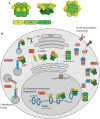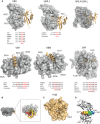The AAA+ ATPase p97, a cellular multitool
- PMID: 28819009
- PMCID: PMC5559722
- DOI: 10.1042/BCJ20160783
The AAA+ ATPase p97, a cellular multitool
Abstract
The AAA+ (ATPases associated with diverse cellular activities) ATPase p97 is essential to a wide range of cellular functions, including endoplasmic reticulum-associated degradation, membrane fusion, NF-κB (nuclear factor kappa-light-chain-enhancer of activated B cells) activation and chromatin-associated processes, which are regulated by ubiquitination. p97 acts downstream from ubiquitin signaling events and utilizes the energy from ATP hydrolysis to extract its substrate proteins from cellular structures or multiprotein complexes. A multitude of p97 cofactors have evolved which are essential to p97 function. Ubiquitin-interacting domains and p97-binding domains combine to form bi-functional cofactors, whose complexes with p97 enable the enzyme to interact with a wide range of ubiquitinated substrates. A set of mutations in p97 have been shown to cause the multisystem proteinopathy inclusion body myopathy associated with Paget's disease of bone and frontotemporal dementia. In addition, p97 inhibition has been identified as a promising approach to provoke proteotoxic stress in tumors. In this review, we will describe the cellular processes governed by p97, how the cofactors interact with both p97 and its ubiquitinated substrates, p97 enzymology and the current status in developing p97 inhibitors for cancer therapy.
© 2017 The Author(s).
Conflict of interest statement
The Authors declare that there are no competing interests associated with the manuscript.
Figures





References
Publication types
MeSH terms
Substances
Grants and funding
LinkOut - more resources
Full Text Sources
Other Literature Sources
Molecular Biology Databases
Miscellaneous

